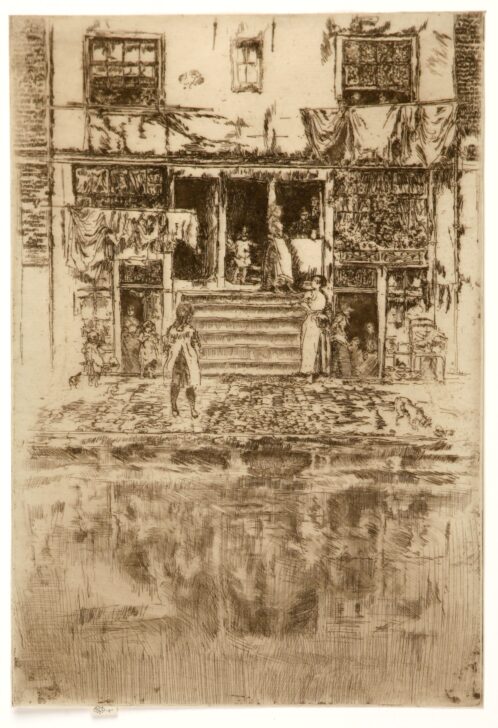Steps, Amsterdam
James Abbott McNeill Whistler

Description
Steps, Amsterdam
1889
Etching and drypoint
Second state of four (Kennedy 403)
Bequest of Margaret Watson Parker, 1954/1.403
Whistler’s Amsterdam etchings often have a darkness and closeness that borders on claustrophobic. Here he zeroes in on the motif, cropping the upper stories of the buildings and using the stagnant water of the back canals to mirror them with little differentiation between structure and reflection. In spite of the humble subjects and the sense of confined space, the Amsterdam prints, with their delicately etched lines, subtle printing in brown ink, and beautifully observed details of daily life, are works of unparalleled beauty. The laundry line and playing children are anecdotal touches that draw the viewer into the world of the image. The gaze becomes absorbed by the interplay between the complex rectangular forms that make up the facade of the house, the cobbled street, and the reflections on the surface of the canal in the foreground, where representation becomes pure form.
Subject Matter:
According to the Glasgow catalogue raisonné, "The shop front of No. 148 Lijnbaansgracht, near the corner of Laurierstraat and Lijnbaansgracht, in the city of Amsterdam, capital of the Netherlands. 7 Beatrice Whistler called it the 'Royen Gracht'. "
Physical Description:
Seen frontally is a building along a canal. In front of the facade is a brick or cobble pavement; steps lead up to a triple doorway entrance while laundry and windows complete the second story. To either side of the central steps are doorways that lead down. In each of the doorways and on the pavement are grouped figures of women and children. The lower portion of the print shows the reflections of the building and figures.
Usage Rights:
If you are interested in using an image for a publication, please visit https://umma.umich.edu/request-image/ for more information and to fill out the online Image Rights and Reproductions Request Form.